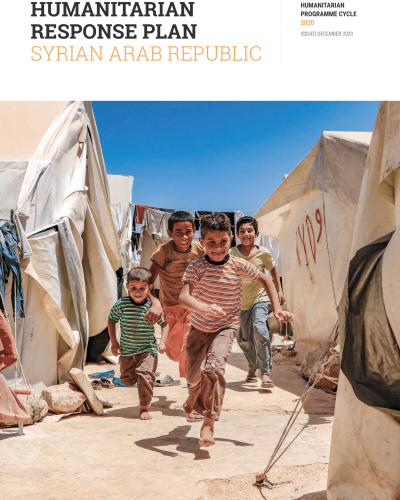2020 Humanitarian Response Plan

The 2020 Humanitarian Response Plan (HRP) sets out the framework within which the humanitarian community will respond to the largescale humanitarian and protection needs in Syria throughout 2020, on the basis of the prioritization undertaken across and within sectors. The HRP, based on United Nations’ (UN) assessments and analysis, presents urgent funding requirements to address these needs. It is anchored by three strategic objectives: saving lives and alleviating suffering, enhancing protection, and increasing resilience. As these objectives are interlinked and often inter-dependent, achieving positive outcomes for affected people requires concerted action across all three. Protection and early recovery are mainstreamed across the HRP framework, adding coherence to the humanitarian response. Progress made towards attaining one objective is often dependent upon incremental steps towards achieving another. Achieving these objectives is contingent upon the availability of sufficient resources and the existence of an enabling operational environment. Humanitarian activities under the HRP are coordinated at field level and benefit from an overarching effort to harmonize assistance across response areas.
At the time of drafting, the Coronavirus disease (Covid-19) had started to be reported in Syria, prompting the establishment of multi-sectoral Covid-19 preparedness and response plans. Response priorities, gaps and financial requirements presented in these hub-level plans are summarized and annexed to this HRP.
The HRP was developed by the UN on behalf of humanitarian partners2 working in Syria, under the leadership of the Humanitarian Coordinator for Syria (HC) and the Regional Humanitarian Coordinator for the Syria Crisis (RHC), with support from the UN Office for the Coordination of Humanitarian Affairs (OCHA).
The HRP was collectively prepared by all partners, consulted with the Government of the Syrian Arab Republic and endorsed by the Emergency Relief Coordinator (ERC), in line with General Assembly resolution 46/182 (A/RES/46/182). Affected people were consulted during the humanitarian needs identification and planning processes.
The Government of Syria and the UN acknowledge that this is a technical and operational humanitarian document and it should not be interpreted as a political document. While the UN and the Government of Syria may have differences in interpretation of certain issues, the primary objective of the document for both parties remains the timely and adequate delivery of humanitarian assistance to people in need in accordance with international law, including the UN General Assembly resolution A/RES/46/182, and the UN Charter.
In accordance with international law, the UN renews its commitment to deliver humanitarian assistance to people affected by the crisis in Syria, and to implement the response plan with full respect of the sovereignty, territorial integrity and independence of the Syrian Arab Republic and in accordance with General Assembly resolution 46/182. The UN is committed to the implementation of Security Council resolutions 2139 (2014), 2165 (2014), 2191 (2014), 2258 (2015), 2332 (2016), 2393 (2017), 2401 (2018), 2449 (2018) and 2504 (2020). The UN and its partners will continue to advocate for greater respect for international law, international humanitarian law (IHL) and international human rights law (IHRL) with relevant stakeholders.
Humanitarian organizations working under this plan, namely: UN agencies, funds and programmes, the Syrian Arab Red Crescent (SARC) and humanitarian international and national non-governmental organizations (NGOs),3 remain committed to providing needs-based humanitarian assistance, in accordance with the humanitarian principles of humanity, neutrality, impartiality and independence and to providing assistance without discrimination to people in need. In this capacity, they are protected under international law.
Organizations participating in the HRP acknowledge that it is first through the efforts of the Syrian people, through state institutions at both central and local level, and national non-governmental organizations that the basic needs of the affected population are met.
Partners also recognize that, under IHL, the state has the primary role and responsibility for the provision of assistance and protection of those affected by the crisis.
This HRP sets out the strategy for a principled, needs-based humanitarian response in Syria, in line with A/RES/46/182 and the principles of IHL. These activities will be carried out in consultation with Syrian state institutions in accordance with the Charter of the UN, General Assembly resolution 46/182 and relevant Security Council resolutions, and is governed by the framework of agreements between the Syrian State and UN agencies, funds and programmes.
People in need
11.06M People in need of humanitarian assistance
People targeted
9.8M Direct assistance
11.4M Service delivery
Requirements (US$)
$3.4BN











